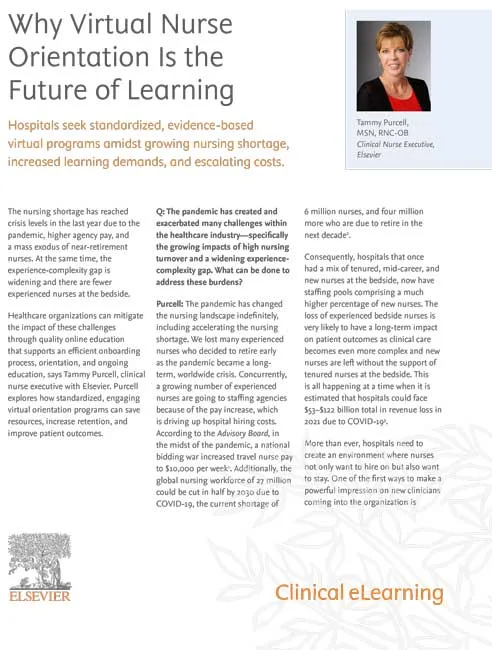
Why Virtual Nurse Orientation Is the Future of Learning
Tammy Purcell
Post-Pandemic Healthcare Path
The nursing shortage has reached crisis levels due to the pandemic, higher agency pay, and a mass exodus of near-retirement nurses. At the same time, the experience-complexity gap is widening and there are fewer experienced nurses at the bedside.
Healthcare organizations can mitigate the impact of these challenges through quality online education that supports an efficient onboarding process, orientation, and ongoing education, says Tammy Purcell, clinical nurse executive with Elsevier. Purcell explores how standardized, engaging virtual orientation programs can save resources, increase retention, and improve patient outcomes.
Q: The pandemic has created and exacerbated many challenges within the healthcare industry—specifically the growing impacts of high nursing turnover and a widening experience complexity gap. What can be done to address these burdens?
Purcell: The pandemic has changed the nursing landscape indefinitely, including accelerating the nursing shortage. We lost many experienced nurses who decided to retire early as the pandemic became a long-term, worldwide crisis. Concurrently, a growing number of experienced nurses are going to staffing agencies because of the pay increase, which is driving up hospital hiring costs. According to the Advisory Board, in the midst of the pandemic, a national bidding war increased travel nurse pay to $10,000 per week. Additionally, the global nursing workforce of 27 million could be cut in half by 2030 due to COVID-19, the current shortage of 6 million nurses, and four million more who are due to retire in the next decade.
Consequently, hospitals that once had a mix of tenured,mid-career, and new nurses at the bedside, now have staffing pools comprising a much higher percentage of new nurses. The loss of experienced bedside nurses is very likely to have a long-term impact on patient outcomes as clinical care becomes even more complex and new nurses are left without the support of tenured nurses at the bedside. This is all happening at a time when it is estimated that hospitals could face $53–$ 122 billion total in revenue loss in 2021 due to COVID-193.
More than ever, hospitals need to create an environment where nurses not only want to hire on but also want to stay. One of the first ways to make a powerful impression on new clinicians coming into the organization is by having an amazing orientation program that is engaging, innovative, and customized to learners. To this point, many exciting changes are happening in nurse education, including a move to blended and flexible online models that focus more on individual knowledge gaps. The long days of orientation in a traditional classroom are being replaced by the flipped classroom model in which learners do virtual work, including pre-assessment tests anywhere at any time, followed by a combination of classroom time, Zoom meetings, and simulation lab virtual reality experience. Learning modalities are more creative with some organizations even doing escape rooms as a part of orientation to help information stick and to give nurses that wow factor they will never forget. This sets up a positive relationship with nurses, leading to greater satisfaction and retention.
Virtual Orientation Courses and Patient Care Quality
Q: How can virtual orientation courses impact the quality of patient care?
Purcell: Orientation provides a foundation in consistent care and quality patient outcomes. Virtual orientation courses enable hospitals to offer standardized, evidence-based education much more expeditiously compared to traditional classroom training and homegrown programs, which is critical due to increasing demands on clinicians today. For example, nurses now use a wide-range of complex technologies from the EHR to myriad monitoring devices, and even specialized beds, all of which require additional learning. Homegrown orientation programs are very labor-intensive to develop and will be more challenging to maintain as learning requirements increase.
Cost-Effective Change: Virtual Orientation & Turnover
Q: Change can be costly. How can incorporating something new like virtual online orientation reduce the financial impact of turnover?
Purcell: Organizations that choose to exchange traditional classroom learning for more efficient virtual orientation can see a significant cost savings as well as increased nurse satisfaction. Virtual education reduces costs by increasing the number of nurses who can be trained in a shorter time frame. The flipped classroom model takes advantage of the speed and efficiency of standardized online learning, which can be highly customized to the identified knowledge gaps of individual learners. Learners need flexible, tailored learning solutions that include a combination of virtual learning, simulation, and other modalities to have that unique experience and to feel like they are on a meaningful professional development journey designed specifically for them. Ultimately, we believe virtual orientation programs are the future of learning.

Why Virtual Nurse Orientation Is the Future of Learning
Download the Whitepaper 打開新的分頁/視窗貢獻者

TP
Tammy Purcell
MSN, RNC-OB, Clinical Nurse Executive, Elsevier